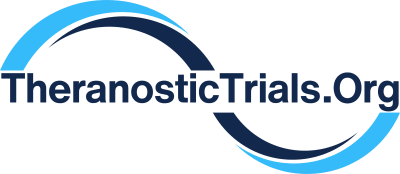Filters
(14 results)
Study Types
Enrolling Status
Study Sponsor Type
Esophageal (GI)
Study Status
Last Updated: Tue Aug 05 2025
Pharmaceutical Trials (Site Sponsors)
🇺🇸

Imaging Diagnostic
This is a multicenter, open-label, prospective Phase 1/2a study to assess safety and tolerability, establish dosimetry and to identify an optimal imaging dose (radioactivity and mass dose) and imaging time window of 64Cu-LNTH-1363S (64Cu Radiolabeled FAPi PET/CT Imaging Agent) and to compare its imaging biodistribution with FAP expression by immunohistochemistry (IHC) in patients with sarcomas or GIT cancers.
🇺🇸
🇬🇧

Treatment Locally Advanced Cancer
In this study, we want to learn how safe and effective the study drug, BAY2701439, is in patients with advanced cancer that has the protein HER2 (Human Epidermal growth factor Receptor 2) and cannot be cured by currently available treatment options.

Imaging Undefined Stage
Ga68 FF58 PET Scan in Solid Tumors (Pancreas, Esophageal, Brain) αvβ3 and αvβ5 (+)
🇨🇦
🇺🇸

Treatment Undefined Stage
Dosimetry trial of Lu177-PNT6555 in selected Solid Tumors
🇺🇸

Treatment Metastatic Cancer
The purpose of this program is to provide access to [Lu-177]-PNT2002 to patients who have been diagnosed with prostate-specific membrane antigen (PMSA)-positive castration-resistant prostate cancer (mCRPC). Patients must have received at least 1 prior androgen pathway inhibitor (ARPI) and cannot be treated by currently available drugs or clinical trials.
Investigator Trials
Pharmaceutical & Investigator Trials (Non-Site Sponsors)
NCT04564482
The overall aim of this pilot study is to prospectively monitor programmed death-ligand 1 (PD-L1) expression dynamics in vivo, during neoadjuvant chemoradiotherapy (CRT) or short-course preoperative radiotherapy (SCPRT) in rectal and esophageal cancer by a positron emission tomography (PET) imaging approach.
Programmed Death-ligand 1 Positron Emission Tomography Imaging During Neoadjuvant (Chemo)radiothErapy in Esophageal and Rectal Cancer (PETNEC): a Prospective Non-randomized Open-label Single-center Pilot Study
NCT05619016
Phase II Study of [68Ga]Ga-ABY-025 PET for Non-invasive Quantification of HER2-status in Solid Tumors
The goal of this phase II clinical trial is to improve the selection of patients with solid tumors who would benefit from effective treatment with HER2 targeted drugs. This will be achieved by examining patients with HER2 positive tumors in the esophagus or stomach or patients with advanced breast cancer with low HER2 expression (HER2low) with the HER2 specific positron emission tomography (PET) tracer ABY-025 (HER2-PET) and compare the imaging results with HER2 expression in tumor tissue derived from biopsies (reference standard).
🇺🇸
NCT06549413
18F-FSPG PET/CT as a Non-Invasive Imaging Biomarker for Treatment Response to Chemoradiation in Esophageal Cancer
This study is being done to learn how 18F-FSPG PET/CT scan results may be related to the response to chemotherapy and radiation in patients with esophageal cancer.
🇳🇱
NCT06645808
The Safety, Tolerability and Biodistribution of a Single Intravenous Administration of Two Zirconium-89 Labelled Vartumabs (F8scFV or C9scFv) in Patients with Solid Tumors - a Phase 0, Open Label, PET/CT Molecular Imaging Basket Trial
VARTUTRACE is a first-in-human PET/CT molecular imaging study in patients with solid tumors. This study will investigate the biodistribution and pharmacology of two antibody fragments binding oncofetal Chondroitin Sulfate (CS). Oncofetal CS are tumor-specific carbohydrate motifs present in proteoglycans and identified by VAR2 Pharmaceuticals as expressed during fetal development. Oncofetal CS reappears in the vast majority of cancers while remaining largely absent from normal tissues. VAR2 Pharmaceuticals recently developed antibodies specific for oncofetal CS. VARTUTRACE uses two of these as radiolabeled antibody fragments to study biodistribution, tumor accumulation, pharmacodynamics and clearance pathways in a diverse patient population.
🇧🇪
NCT06782412
Multicenter Validation Trial of [18F]AlF-FAPI-74 for PET Imaging of Cancer-associated Fibroblasts Through Fibroblast Activation Protein Inhibitors (FAPI) in Different Tumor Types
The aim of the project is to demonstrate superior detection ratio of [18F]AlF-FAPI-74 PET/CT compared to [18F]FDG PET/CT or conventional imaging in treatment-naïve, newly diagnosed patients with oesophagogastric adenocarcinoma (clinical T1-4N0-3M0) and pancreatic ductal adenocarcinoma (clinical T1-4N0-2M0-1) and describe the clinical utility of [18F]AlF-FAPI-74 PET/CT in oncological patients with a clinically challenging situation.
NCT04314349
Radiogenomics in Aerodigestive Tract Cancers
Aerodigestive tract cancers are common malignancies. These cancers were ranked to be top-ten cancer-related deaths in Taiwan. Although many new target therapies and immunotherapies have emerged, many of the treatment eventually fail. For example, a 30-40% failure rate has been reported for target therapy, and, even higher for immune checkpoint inhibitors. A reliable model to more accurately predict treatment response and survival is warranted. The radiomic features extracted from F-18 fluorodeoxyglucose (18F-FDG) positron emission tomography (PET) can be used to figure tumor biology such as metabolome and heterogeneity. It can therefore be used to predict treatment response and individual survival. On the other hand, genomic data derived from next-generation sequencing (NGS) can interrogate the genetic alteration of cancer cells. It can be used to feature genetic identification of the tumor and can also be used to identify target genes. However, both modalities have their weakness; a combination of the two may devise a more powerful predictive model for more precise clinical decision. The investigators plan to recruit patients aged at least 20-year with the diagnosis of aerodigestive tract cancers for radiogenomic study. Our previous studies have found that radiomic features derived from 18F-FDG PET can predict treatment response and survival in patients with esophageal cancer treated with tri-modality method. The investigators also discovered that radiomics could predict survival in patients with EGFR-mutated lung adenocarcinoma treated with target therapy. In addition, our study results showed that the level of PD-L1 expression is associated with radiomics as well. The investigators plan to add genomic data into radiomics and interrogate cancers from different aspects. The investigators seek to devise a more precise model to predict the treatment response and survival in patients with aerodigestive tract cancers.
NCT05784597
A Phase I Study to Evaluate the Safety and Dosimetry of 68Ga-labelled OncoFAP Derivatives in Patients With Solid Tumors
Phase I, multicenter study in patients with a confirmed diagnosis of solid tumor among breast cancer, colorectal cancer, oesophageal cancer and pancreatic adenocarcinoma, requiring clinical staging for nodal staging and/or metastatic disease (based on institutional practice and risk stratification). All patients will receive a single intravenous bolus administration of 250 MBq (225 - 275 MBq). [68Ga]Ga-OncoFAP biodistribution, PK, and dosimetry of [68Ga]Ga-OncoFAP will be assessed based on a series of PET/CT scans, blood and urine sampling.
NCT04514822
Quantitative Evaluation of Metastatic Lymph Nodes With Dynamic 2-[18F]Fluoro-2-deoxy-glucose (18F-FDG) Positron Emission Tomography/Computed Tomography in Patients With Esophageal Squamous Cell Carcinoma
Currently, static scans are commonly used for Positron Emission Tomography/Computed Tomography (PET/CT) examination in the literature. Accordingly, functional images of 2-[18F]fluoro-2-deoxy-glucose (18F-FDG) Positron Emission Tomography/Computed Tomography (PET/CT) with dynamic scans can be more sensitive to detect metastatic lymph node, since the introduction of temporal dynamic variables would provide more imaging quantification than conventional static scans. The purpose of this study is to provide the dynamic 18F-FDG PET/CT imaging for esophageal squamous cell carcinoma (ESCC) patient to quantify the difference between malignant lymph nodes (MLN) and benign lymph nodes (BLN).
NCT05615103
The Efficiency of 18F-FDG PET-CT for Predicting Advanced Oesophageal Squamous Cell Carcinoma Patients' Tumor Response to Immunochemotherapy in the Neoadjuvant Setting
Treatment with immune checkpoint inhibitors such as programmed death receptor 1 (PD-1 inhibitors) for advanced and metastatic esophageal squamous cell carcinoma (ESCC) significantly improves patients' overall survival compared to chemotherapy alone. Despite this milestone breakthrough, immunochemotherapy also has known limitations. Indeed, only 45-72% of patients achieved objective responses [1-5]. It is urgent to find out easily-determined and convenient biomarkers to identify patients who will benefit from such treatment modality. Due to the luminal structure of the esophagus, the exact diameter of esophageal tumor cannot be precisely measured per RECIST 1.1. Moreover, the definition of the metastatic lymph node in which the short-axis lengths should be longer than 1.5 cm hinders the risk of missing the smaller metastatic lymph node foci. Thus, it is difficult to implement morphology-based criteria for evaluating the neoadjuvant immunochemotherapy response. The current study aimed to investigate the role of iPERCIST in predicting tumor response and the short-term overall survival of patients with locally advanced ESCC after neoadjuvant immunochemotherapy.



